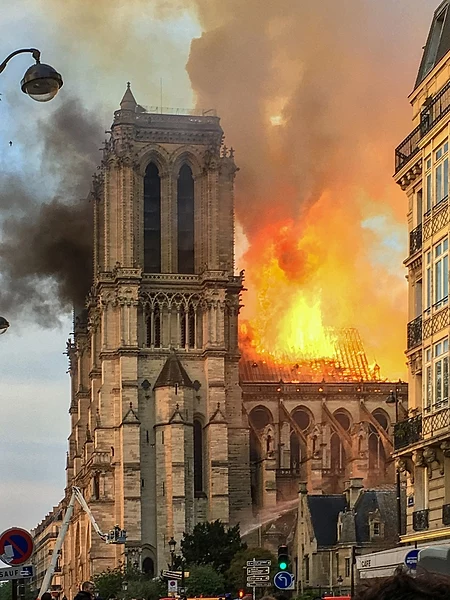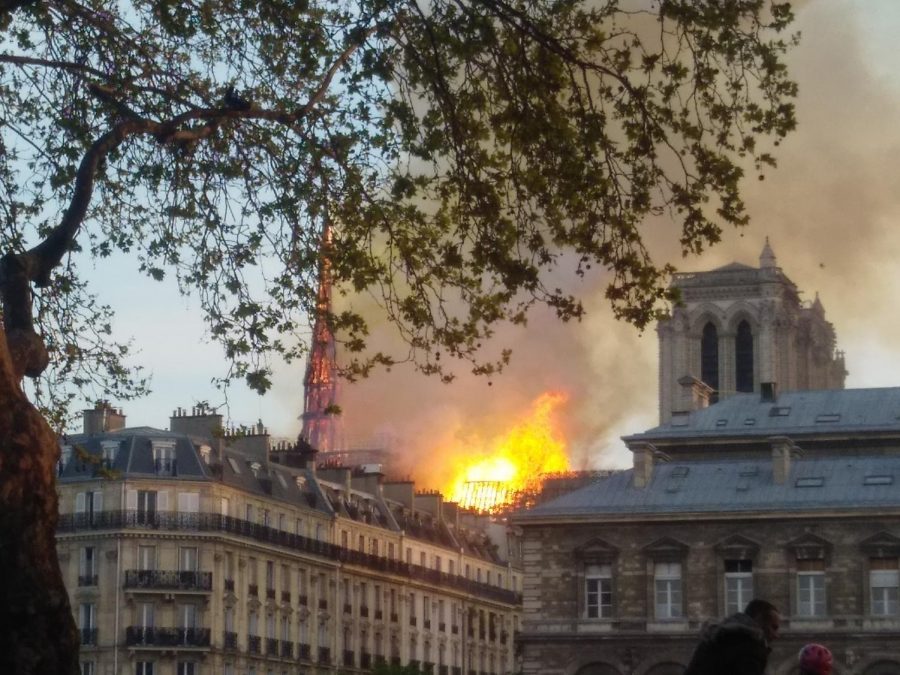Notre Dame on Fire: the tragic loss of art, history, and culture
April 17, 2019
The Cathedral of Notre Dame in Paris is one of the most significantly-religious landmarks in Western history and is a gemstone of French culture. The nearly 900-year-old place of worship caught fire on April 15, 2019 around 6:30 pm local time, supposedly because of complications during restoration efforts. Luckily, there were no human deaths; although, one firefighter was severely injured. The only known deaths are those of the roof and interior of the cathedral, and of Parisian spirits.
The gothic cathedral began construction in the mid-1100s under Pope Alexander III and was completed by the mid-1300s. Its framework is comprised of lumber, earning the structure the name “the forest,” so it was no surprise that it burned so easily. Its design seems to work against gravity, making it difficult to extinguish and vulnerable to collapse. The burning brought down its spire, captured in this already-infamous video:
[wpdevart_youtube]JNx3tMEV45c[/wpdevart_youtube]
The entire wooden interior has been reportedly lost. Much of art that makes Notre Dame so famous was sculpted to the walls with no way of salvaging.
Thanks to the hard work of the Paris firefighters, the main structure of Notre Dame was saved from certain doom. The exterior is adorned with elaborate facades and buttresses, decorated with religious imagery, gargoyles, and chimères. The 226-foot tall main bell towers, completed in the mid-1200s, remain intact. Its 15th-century main bell, called Emmanuel, resides in the South tower and is the inspiration for Victor Hugo’s 1831 novel The Hunchback of Notre Dame. It rings for special occasions, such as when it rang to mark the end of World War II, or to recognize the September 11 terror attacks.
However, it is unclear as of yet just how much artistry was ruined by fire, heat, and smoke. The cathedral is known for its gorgeous 13th-century Rose Windows, which shed light and color on the artistry inside. The Great Organ is the largest organ in France, with pipes from medieval times. The states of both are unknown.
 Notre Dame is the keeper of many items sacred to Christianity. Intricate statues, sculptures, and paintings depicting biblical scenes and saints were displayed there. Some art, monuments, and religious items were saved from the fire. By happenstance, the sixteen copper statues of the twelve apostles and four evangelists had been moved last week for the very construction that might have been the cause of the fire. Perhaps most significant of its items, it housed artifacts sacred to Christianity. The Crown of Thorns is said to be the one Jesus wore during his crucifixion when He was mocked by the Roman soldiers. Along with it is a fragment of the True Cross, and one of the Holy Nails by which He was held on to the cross. These holy artifacts are believed to have survived the conflagration.
Notre Dame is the keeper of many items sacred to Christianity. Intricate statues, sculptures, and paintings depicting biblical scenes and saints were displayed there. Some art, monuments, and religious items were saved from the fire. By happenstance, the sixteen copper statues of the twelve apostles and four evangelists had been moved last week for the very construction that might have been the cause of the fire. Perhaps most significant of its items, it housed artifacts sacred to Christianity. The Crown of Thorns is said to be the one Jesus wore during his crucifixion when He was mocked by the Roman soldiers. Along with it is a fragment of the True Cross, and one of the Holy Nails by which He was held on to the cross. These holy artifacts are believed to have survived the conflagration.
Notre Dame typically attracts tens of thousands of visitors each day, but seeing that it is Holy Week– the most important time of the Roman Catholic calendar– the attendance was most likely higher. As the cathedral burned, the world could hear the lamentations of the onlooking Parisians: crying, praying, and singing “Ave Maria.”
Though French president Emmanuel Macron promises to rebuild, nothing could ever replace its history, its walls which have withstood hundreds of years of human history. It stands witness to the change in leadership from the Church to the State, the births of new sects of Christianity, a ransacking during the French Revolution, and both World Wars, despite the country being torn apart at the seams in each. Notre Dame has always stood tall, a beacon of light and hope for Catholics around the world. Although Notre Dame can be restored, the devastating loss of more than 800 years of French heritage, art history, and Catholic culture cannot be replaced.
View the interior of Notre Dame and its items here: http://www.notredamedeparis.fr/en/la-cathedrale/linterieur/






















































